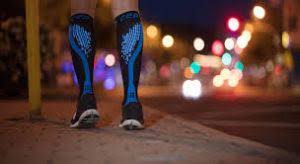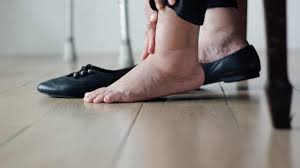
Is it safe to wear compression socks for 24 hours straight?
Usually not.
Most experts agree that you should take off compression socks while you sleep so that they don’t restrict blood flow while you’re lying down.
The good news is that the adverse side effects of wearing compression socks are rare under most circumstances.
Let’s talk about how long you can safely wear compression socks in a given day.
We can also dispel common myths about compression socks.
Then we’ll walk you through their proper use.
We’ll even dig a little deeper into how compression socks work and whether wearing them – even for 24 hours straight! – is an option for you.
What are Compression Socks and How Do They Work?
Compression socks help improve blood circulation. Often recommended by doctors to aid blood circulation, they’re an effective, safe, and inexpensive alternative for managing blood circulation. Let’s take a look at how compression socks can help improve your overall health.

Sometimes, your veins need a little help getting blood back from your legs to the heart. Usually, this help comes from the calf muscle acting as a small pump. As you walk and move about, muscle contractions help keep the blood moving up towards the heart.
Young, healthy kids, especially those who can’t stay still for more than 10 minutes, usually have no problem making their calf muscles do their work. Most adults sit all day, however, and this situation prevents their calf muscles from functioning properly.
By wearing compression socks, you provide a small amount of external pressure to the veins in your legs. The pressure created by compression socks helps the valves in your veins effectively keep blood flowing to your heart.
When these valves function well, they can prevent blood from pooling, especially in one’s leg area, prevent edema or the swelling caused by excess fluid trapped in your body’s tissues.
Graduated compression stockings, designed to be tightest around the ankles, exert pressure on the ankles, and eases up towards the knees. Your physician will recommend the pressure specification of the stockings you should use (written as mmHg or millimeters of mercury).
Can You Wear Compression Stockings 24 Hours a Day? No.
Are Compression Socks Right for You?

Given people’s lifestyles nowadays, wearing compression socks should benefit people more than if they don’t. However, it is always crucial to understand your body and be aware of any underlying medical conditions before using medical-grade compression products.
For instance, if you regularly experience swelling in your feet, consulting your physician should be the first thing you do. Your physician should then be capable of identifying the cause of your edema and recommend if compression socks are right for you.
In some cases, an underlying condition might render compression socks ineffective. If your doctor OKs your use of compression socks, ask them to confirm the level of compression that would suit you best.
Who Should Wear Compression Socks?
Depending on the compression level of compression socks, people use compression socks for a wide variety of purposes. For example, 20-30 mmHg socks are great for people who suffer from varicose veins and edema.
The extensive list below highlights those who might benefit from wearing compression socks. If you answer yes to any of the questions below, you are an excellent candidate for compression stockings.

- Do you sit all day?
- Do you stand all day?
- Are you going on a long flight?
- Do you suffer from edema frequently?
- Are you seeking relief from painful varicose veins?
- Has your doctor recommended compression therapy?
- Are you pregnant and suffering from swollen feet and ankles?
- Are you at risk of developing deep vein thrombosis (DVT)?
- After an exercise session, are your legs tired and achy long after your workout?
Who Shouldn’t Wear Compression Socks?
Some medical conditions will preclude you from wearing compression hosiery altogether. This list is by no means conclusive, though. That’s why it’s important to consult a physician to ensure that compression therapy is right for you. It is best to avoid compression socks in the following instances:
- If you’re diagnosed with ischemia
This disease affects how your arteries distribute oxygenated blood to your extremities. The added compression can cause further complications to an already weak circulatory system.
- If you’re allergic to certain materials
Certain materials used to make the compression garments may exacerbate your allergies.
- If you’re suffering from skin sensitization disorders such as peripheral neuropathy (caused by damage to the nerves in your extremities)
Properly fitting your compression socks to suit the shape of your leg is a critical component of compression therapy. If your nerves are damaged, your body will not transmit sensations of discomfort, like whether the socks are too tight, for instance, which may cause additional complications.
- If you have complications arising from diabetes or congestive heart failure
Although compression can help relieve some of the swelling caused by these chronic conditions, it is not suitable for all cases. Consult your physician before using compression socks.
- If your compression socks are Doc Socks or Sock Soothers
Customers who have purchased from these companies have left many complaints and negative reviews. The Better Business Bureau is currently monitoring these companies as potential scams.
How Long is Too Long When Wearing Compression Socks?

Those who sit or stand for long periods should benefit from the use of pressure stockings and compression socks since they help your veins counter the effects of gravity. However, one can argue that you can achieve the same effect by elevating your legs and letting gravity do the work for you.
In some cases, a physician may recommend that you wear compression garments at night, especially for those who have recently had surgery and are at risk of developing a blood clot. In these cases, they will recommend light compression garments for nightwear.
Unless your physician specifically asks you to keep your pressure socks on at night, however, take them off when going to bed. Your skin deserves a break at day’s end, and removing the compression socks will allow for better airflow and healthier skin.
However, if you are on your feet for 24 hours or sitting for a long 20-hour flight, wearing your compression garments throughout these periods is a good idea. Are compression socks good for sitting all day? Yes! As long as you wear them correctly, your compression socks will work for you and not against you.
Possible Side Effects of Wearing Compression Socks for Too Long
While it’s important to note that the health benefits of compression therapy far outweigh the risks of minor side effects, some people do have minor reactions to long-term use of compression garments including:
- Itching
- Broken skin
- Skin irritation
- Temporary impressions on the skin
If your compression socks don’t fit properly or are worn non-stop for days at a time, you may also develop corns and calluses or experience having circulation cut off completely. Hence, the need to emphasize the importance of wearing your compression socks as prescribed for a safe and beneficial experience.
Related Articles
- Compression Sleeves for Legs
- Compression Socks for Men
- Best Compression Socks for Swelling
- Medical Compression Socks
- Wide Calf Compression Socks
- Easy To Put On Compression Socks for Elderly
- Toeless Compression Socks
- Do Compression Socks Help Gout
How to Wear Your Compression Socks
First, make sure you have a properly sized pair. They make them all the way from size Small to Extra Wide Compression Socks and even 3XL compression socks for obese legs.

Since compression stockings and socks need to fit snugly, the tight fit can make it a little tricky to put on. Follow the steps below when putting on your compression stockings.
Step 1: Turn the socks inside out.
Reach into the sock and get a hold of the heel area. Pull it outwards, creating a little pocket for your foot. Do not pull out the entire leg length.
Step 2: Put the sock onto the heel.
When you insert your foot into the little pocket you have made, don’t try to pull the sock up to the knee just yet. Instead, focus on fitting it onto the heel.
Step 3: Pull the sock up to the middle of your shin.
Reach for the overlap that is currently covering your toes. Grasp the overlapped fabric and pull it up towards the knee. You will want to do this in one fluid motion to keep the sock from forming wrinkles.
Step 4: Pull the remaining fold up to your knee.
With the last motion, ensure that you smooth out any gathers and folds that may have formed. Wrinkles in the fabric could increase the pressure on a section of your leg, leading to circulatory problems and discomfort.
Your sock should feel snug but comfortable. If you feel pain, this could be an indication that your compression socks are too small.
Fight the urge to fold the socks at the top. Folds may cause too much pressure around the knee area and keep your blood from circulating properly.
Takeaway
How long you wear your compression socks should be based on your particular needs. Your legs will mostly need help to counter gravity when they are below you, whether you’re seated or standing. Elevating your legs should allow blood in your leg area to travel back to your heart more easily.
Not everyone, though, will have the luxury to put up their legs at a time they need to do it most, such as on long flights or while at work. Meanwhile, professions like nursing may entail people to be on their feet for extended hours and makes compression sleeves a daily necessity.
Compression therapy, however, like most treatments, is not a “one-size-fits-all” solution. Consult a physician to find out what options will work best for you.
This page last updated December 10, 2022
